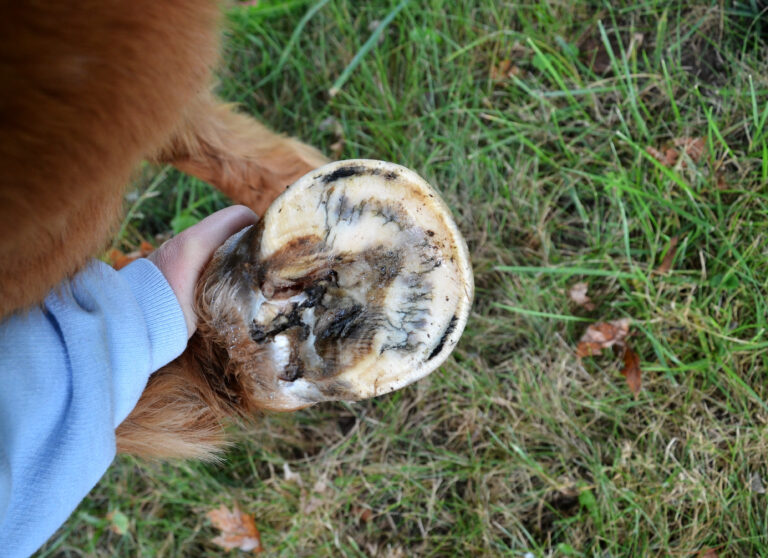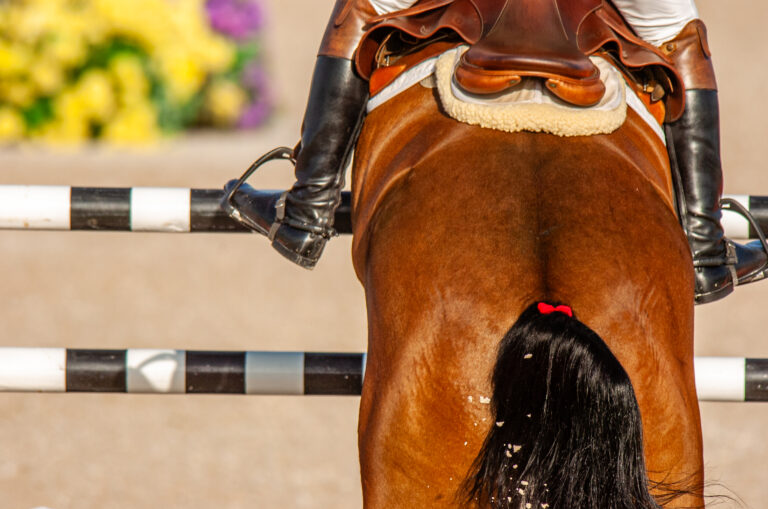An understanding of the WIDTH protocol that I developed (considering Work, Intensity, Duration, Terrain, Horse) can answer the question, “Does my horse need shoes, or can he go barefoot?” These are a few other common questions horse owners ask about shoes and barefoot trims.
Can Horseshoes Harm My Horse’s Feet?
When applied improperly, yes. Just like anything we do with horses—training, veterinary care, trailering, for example—shoeing can hurt a horse when it’s done incorrectly. Done appropriately, and for the right reasons, shoes offer support to the hoof structures, enhance motion, prevent cracking, and protect the hoof from hard terrain. Therapeutic shoes can even help lame horses become and stay sound. Shoes designed for particular sports or work also enhance a horse’s performance ability.

Does My Horse Need Shoes?
It depends. Natural models work well for wild horses. Constant roaming adequately wears the hoof, and the foot adapts to the varied landscape. A feral horse either adjusts to his environment or does not live to reproduce. Nature culls those with poor hooves; humans do not. Some domestic horses can also go barefoot. For example, a horse that wears shoes in the summer while in heavy work often has his shoes removed in the fall and is left barefoot when not being ridden through the winter. Other horses are comfortable and sound under saddle without shoes all year round.
It’s okay to be curious about how shoes might support your riding goals. Just because a horse isn’t lame or is working reasonably well barefoot doesn’t mean he is performing to the best of his ability. A horse that needs shoes to do his job but is denied them will underperform or suffer. Shoes give horses competitive advantages, such as traction, gait correction, and enhancement.
To get a better understanding, consider asking your farrier these questions:
- What makes my horse a good candidate for shoes?
- How might shoes help my horse?
- How do shoes support peak performance in my discipline?
Appropriate, skillful farriery is a combination of trimming and shoeing with decisions made based on the individual horse, rather than taking a one-size-fits-all approach. Farriers consider multiple factors but recognize that trimming is the first step to deciding whether to leave a horse barefoot or to use a shoe. Regardless of the farrier’s skills in shaping a shoe, when the hoof isn’t trimmed correctly, the shoe will not be compatible. Essentially, the trim creates the blueprint for a shoe. Think about your own footwear—if you wear size 9, size 8 is never going to fit. At a minimum, poorly fitted shoes are uncomfortable. Worn for extended periods of time they can leave blisters and potentially lead to larger issues in your feet and legs.
The same is true in horses. Improperly fitted shoes interfere with a horse’s gait and add unnecessary strain on the hoof wall, which can lead to problems. A horse with poorly fitting or inappropriate shoes is better off without them.

Can My Horse’s Shoes Just Be Reset?
Since horseshoes are durable, it is possible to reuse the same pair or set on a horse multiple times. The amount of work a horse does and his individual conformation establish how quickly shoes need to be replaced. There is no benefit to using new shoes at each shoeing when the last set is in good condition. In fact, some horses appreciate the wear pattern that has developed in the old shoes.
If a horseshoe is not worn much and fits properly after trimming, the farrier will make sure the shoe is flat and nail it back on. When the same shoes are applied again it is called resetting or refitting. A farrier may even use the wear patterns on old shoes as a guide for producing new shoes. Uneven shoe wear patterns can suggest a necessary alignment change through trimming. The exception is that a lame horse breaks in the shoe to be comfortable to his foot—much like your sneakers or boots mold to your footfall.
Horseshoes with Borium made of tungsten carbide or Drill-Tech studs are reset many times and often the nail holes wear before the actual shoe. Shoes made of lighter-weight materials wear sooner and may not be able to be reset even once. In some parts of the United States, the ground conditions are so abrasive that shoes become too worn in one shoeing cycle to reset.
Some horses are extra hard on shoes and wear them out quickly while others produce no wear at all.
Resetting shoes is practical for making the most out of the materials used. In some cases, new horseshoes at every visit—especially those with modifications—can increase the cost unnecessarily.
What Should I Know About Going Barefoot?
Not all horses wear horseshoes. In fact, with approximately nine million horses in the United States, fewer than two million are shod regularly every year. Barefoot (shoeless hoof management) has gained popularity for a variety of reasons. One is the expense of shoeing. Competitive riders can pay over $150 every five to six weeks to maintain properly fitted shoes. Over a year’s time that can add up, so sometimes leaving a horse barefoot is viewed as a cost savings. However, skipping the shoes based on budget alone may lead to more costly expenses if the horse physically needs shoes.
Barefoot trimming has also become popular in recent times as horse owners are increasingly interested in keeping horses in a natural state, but many horse activities are unnatural to horses: riding disciplines and stabling conditions are not what would be found in the wild. The decision to permanently maintain a barefoot horse requires a plan rather than simply deciding to leave shoes off. Working with a farrier who understands your horse’s feet will help assess the horse’s hoof condition and whether he can be left barefoot. Horses with naturally thick soles and hoof walls are more likely able to produce enough hoof material to sustain being shoeless. Correct conformation is also necessary to keep the hoof wear in balance. The worst candidates for going shoeless while working are those with thin soles and hoof walls and horses with poor conformation. Often, these horses have coffin bone defects from an inherent weakness that typically emerge as persistent hoof wall cracks.
Going shoeless should not be done on a whim, especially if your horse has worn shoes for some time. There needs to be an assessment to see if the horse is a good candidate and a plan must be created to achieve the desired results. It’s important to ask, “What am I gaining or losing by going with this option?”
The transition from shod to barefoot is best accomplished at the end of a normal shoeing cycle.
After removing the shoes, the farrier trims the hoof longer than he would if resetting a shoe. Leaving a little extra sole and hoof wall helps the horse adjust to being shoeless.
Many riders in colder climates tend to remove a horse’s shoes at the end of a riding or showing season, usually before winter sets in. The idea is to “give the hooves a rest.” There is nothing wrong with doing this. However, weather conditions differ year to year. The best winter scenario for maintaining healthy feet is a constant snowpack. When this happens, most horses do remarkably well barefoot. Inconsistent winters with frequent freeze/thaw cycles are not barefoot friendly. Neither is bare, frozen ground. In this scenario, there is excessive wear on hooves and severe impact on internal structures. When a long hard freeze stiffens up the ground, farriers are often called to put shoes back on these sore-footed horses. In the worst-case scenario, coffin bone fractures and ligament tears can occur simply by a horse walking on rough frozen mud. The wet conditions are also more likely to cause thrush and lead to softer hoof walls, which will be more susceptible to large tears when the wintry mix freezes.
Some horses require extra attention to shift from wearing shoes to going without, and the process may take six months to one year. Hoof casts and nutritional changes can be used to build hoof strength. It may take several applications with proper trimming to develop a proper barefoot hoof.

This excerpt from Shoeing the Modern Horse by Steven Kraus, CJF, with Katie Navarra, is reprinted with permission from Trafalgar Square Books (www.HorseandRiderBooks.com).











